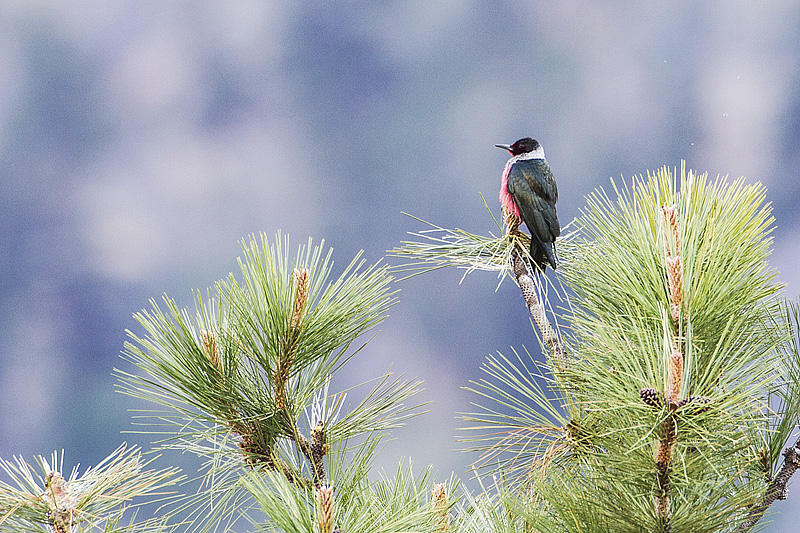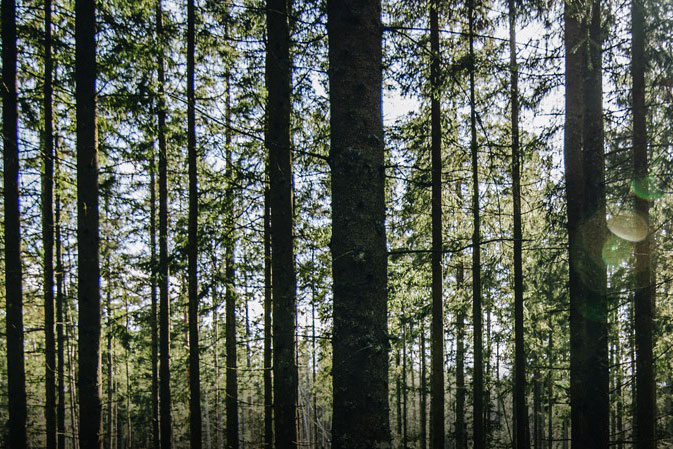The northern edge of the Lewis’s Woodpecker’s range extends into southern interior BC and, to a very small extent, western Alberta.
Lewis’s Woodpecker
(Melanerpes lewis)
Habitat Ecology
- The Lewis’s Woodpecker, unlike most other woodpeckers, catches insects mid-air during the spring and summer. Thus, this species needs open habitats with dense ground cover over which to hunt.1
- This species is mainly found in open ponderosa pine, open riparian cottonwood, and logged or burned pine forests.1
- Their habitat requirements include <30% crown closure and scattered/clumped large-diameter nesting trees.2
- Riparian black cottonwood stands near open areas for foraging are important habitat in the Okanagan and Thompson regions,2 but these may experience high predation if near intense agricultural development/grazing.3
- Burned forests may represent the highest-value habitats for this species, particularly crown-burned ponderosa pine stands and/or 2- to 25-year-old burns.4
- This weak cavity nester will either reuse cavities or excavate new nests in heavily decayed, large-diameter snags (especially broken-topped snags and Douglas fir, ponderosa pine, or cottonwood).2,5

Response to Forest Management
- This species’ foraging habitat quality is declining due to decades of fire suppression and forestry, which have caused many open ponderosa pine forests to be filled in by dense Douglas fir.2
- The main threats to this species include fire suppression and fuel management (understory vegetation removal). Forest harvesting in itself is not considered an important threat because Lewis’s Woodpecker’s preferred habitat contains tree densities too low for commercial forestry.6
- Unlike most woodpeckers, Lewis’s Woodpecker appears to benefit from salvage logging (e.g., up to 40% removal of snags >23 cm dbh), provided nest trees are retained (see Stand-level Recommendations).4,7
Stand-level Recommendations
- When salvage logging burned ponderosa pine/Douglas fir forest, the following retention patch characteristics are recommended:
- Patches should be of variable size but greater than 1 ha8, and reach an average minimum snag density of 6 snags/ha within the salvaged area.9
- Patches should contained relatively severely burned trees.10
- Patches should contain high densities of large-diameter ponderosa pine, black cottonwood, or Douglas fir snags with evidence of heartrot, broken tops, or broken limbs.8 Where possible, retain trees >50 cm dbh.9
- Large-diameter trees and snags, including high-cut stumps or stubs (e.g., 5 m in height) dispersed across the salvaged area will also likely contribute to habitat quality while maintaining open conditions.8,11
- Patches retained on steep slopes are not likely to contribute to high-value nesting habitat.5
- Near potential or known nest areas, strategic silviculture may improve foraging habitat by maintaining high understory diversity including fruiting shrubs (especially chokecherry).6
Landscape-level Recommendations
- Managers should maintain open (<30–35% canopy closure) forest areas dominated by ponderosa pine, black cottonwood or Douglas fir. These forests should be old enough to contain large (>45 cm dbh) snags of decay classes 2–4 (ponderosa pine) or 4–7 (Douglas fir).9
- Mature riparian cottonwood stands with 5–80% canopy closure and large-diameter trees (>60 cm dbh) should also be maintained, particularly stands that are not immediately adjacent to high-intensity agriculture and/or grazing.3
Important Note on Conserving this Species
- BC has established Wildlife Habitat Areas and Wildlife Management Areas that include suitable habitat for Lewis’s Woodpecker, and the federal Management Plan9 contains a more extensive list of BMPs for directly managing this species-at-risk. Critical habitat has been defined for the Okanagan-Similkameen, Thompson-Nicola, Boundary, East Kootenay, West Kootenay, and Cariboo-Chilcotin regions; it is the responsibility of the forest operator to review the federal Recovery Strategy for this species and identify critical habitat within the managed area.
References
- Vierling, K. T., Saab, V. A. & Tobalske, B. W. 2013. Lewis’s Woodpecker (Melanerpes lewis), version 2.0. in The Birds of North America (Rodewald, P. G., ed.) Cornell Lab of Ornithology, Ithaca, New York, USA. Available online: https://doi.org/10.2173/bna.284
- COSEWIC. 2010. COSEWIC assessment and status report on the Lewis’s Woodpecker Melanerpes lewis in Canada. Committee on the Status of Endangered Wildlife in Canada, Ottawa. x + 23 pp.
- Saab, V. A. & Vierling, K. T. 2001. Reproductive success of Lewis’s woodpecker in burned pine and cottonwood riparian forests. The Condor 103: 491–501. Available online: http://www.jstor.org/stable/1369820
- Saab, V. A., Russell, R. E. & Dudley, J. G. 2007. Nest densities of cavity-nesting birds in relation to postfire salvage logging and time since wildfire. The Condor 109: 97–108. Available online: http://www.bioone.org/doi/abs/10.1650/0010-5422(2007)109[97:NDOCBI]2.0.CO;2
- Vogeler, J. C., Yang, Z. & Cohen, W. B. 2016. Mapping suitable Lewis’s woodpecker nesting habitat in a post-fire landscape. Northwest Science 90: 421–432. Available online: http://www.bioone.org/doi/pdf/10.3955/046.090.0404
- Environment Canada. 2016. Recovery Strategy for the Lewis’s Woodpecker (Melanerpes lewis) in Canada [Proposed]. Species at Risk Act Recovery Strategy Series, Environment Canada, Ottawa. vi + 40 pp.
- Saab, V. A., Russell, R. E. & Dudley, J. G. 2009. Nest-site selection by cavity-nesting birds in relation to postfire salvage logging. Forest Ecology and Management 257: 151–159.
- Gebauer, M. 2004. Lewis’s Woodpecker. in Accounts and Measures for Managing Identified Wildlife (Version 2004) Biodiversity Branch, Identified Wildlife Management Strategy, Victoria, BC.
- Environment Canada. 2014. Management Plan for the Lewis’s Woodpecker (Melanerpes lewis) in Canada. Species at Risk Act Management Plan Series, Environment Canada, Ottawa. iii + 23 pp.
- Russell, R. E., Saab, V. A. & Dudley, J. G. 2007. Habitat-suitability models for cavity-nesting birds in a postfire landscape. Journal of Wildlife Management 71: 2600–2611.
- Bonar, R. 2018. Personal communication. April 6, 2018








